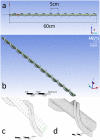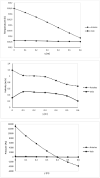A computational fluid dynamics modelling of maternal-fetal heat exchange and blood flow in the umbilical cord
- PMID: 32722669
- PMCID: PMC7386597
- DOI: 10.1371/journal.pone.0231997
A computational fluid dynamics modelling of maternal-fetal heat exchange and blood flow in the umbilical cord
Abstract
Human fetal thermoregulation, maternal-fetal heat exchange, and the role of the umbilical cord in these processes are not well understood. Ethical and technical limitations have restricted current knowledge to animal studies, that do not reflect human morphology. Here, we present the first 3-dimensional computational model of the human umbilical cord with finite element analysis, aiming to compute the maternal-fetal heat exchange. By modelling both the umbilical vein and the two umbilical arteries, we found that the coiled geometry of the umbilical artery, in comparison with the primarily straight umbilical vein, affects blood flow parameters such as velocity, pressure, temperature, shear strain rate and static entropy. Specifically, by enhancing the heat transfer coefficient, we have shown that the helical structure of the umbilical arteries plays a vital role in the temperature drop of the blood, along the arterial length from the fetal end to the placental end. This suggests the importance of the umbilical cord structure in maternal-fetal heat exchange and fetal heat loss, opening the way for future research with modified models and scenarios, as the basis for early detection of potential heat-transfer related complications, and/or assurance of fetal wellbeing.
Conflict of interest statement
The authors declare that they have no competing interests.
Figures



References
-
- Walker D, Walker A, Wood C. Temperature of human fetus. J Obstet Gynaec Brit Cwlth. 1969; 76:503–511. - PubMed
Publication types
MeSH terms
LinkOut - more resources
Full Text Sources

